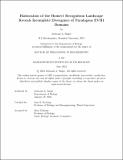Elaboration of the Homer1 Recognition Landscape Reveals Incomplete Divergence of Paralogous EVH1 Domains
Author(s)
Singer, Avinoam A.
DownloadThesis PDF (135.9Mb)
Advisor
Keating, Amy E.
Terms of use
Metadata
Show full item recordAbstract
In recent decades, the structure-function paradigm has been challenged by the discovery that many proteins contain unstructured regions that are necessary for the proper function of their encompassing proteins. Some of these intrinsically disordered regions are responsible for mediating protein-protein interactions that are critical for cellular processes such as protein localization, supermolecular assembly, and cell signaling. Many of these interaction sites are encoded as modular sequences of 3-10 residues which bind to recognition domains. Being able to systematically identify interactions mediated by these Short Linear Motifs (SLiMs) is instrumental to unraveling the many biological processes regulated by this class of interactions. Characterizing the binding preferences of specific SLiM binding domains is key to both predicting interactions and disrupting them for therapeutic purposes. In this study, I apply high-throughput screening of a proteome-derived peptide library to investigate the SLiM binding properties of the synaptic scaffolding protein Homer1. In doing so, I uncover that the reported Homer1 motif fails to capture the diversity of sequences that can bind to its EVH1 domain, and how sequences flanking the core motif can modulate the affinity and specificity of these interactions. Surprisingly, Homer1 preferentially binds to sequences that simultaneously match the motif of a related EVH1 domain from the Ena/VASP family of actin regulatory proteins. An analysis of EVH1 binding preferences in distantly related orthologs suggests that this overlapping preference originated in the ancestral domain that gave rise to distinct Ena/VASP and Homer protein families. The incomplete divergence between Ena/VASP and Homer, coupled with the existence of proteomic sequences capable of binding to both, indicates that competition between these families is likely averted through external regulation that extends beyond the binding preferences inherent to each family. Alternatively, in certain instances, such competition may serve as an advantageous mechanism for molecular decision making, as has been observed with other SLiM binding domains.
Date issued
2024-05Department
Massachusetts Institute of Technology. Department of BiologyPublisher
Massachusetts Institute of Technology